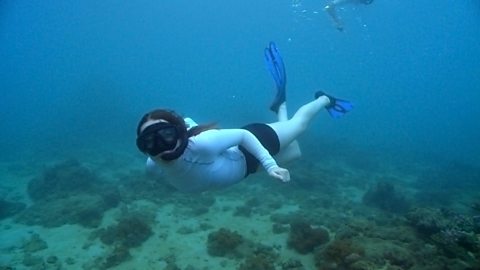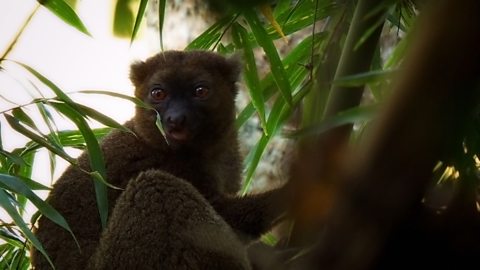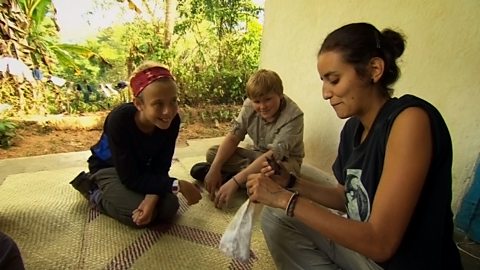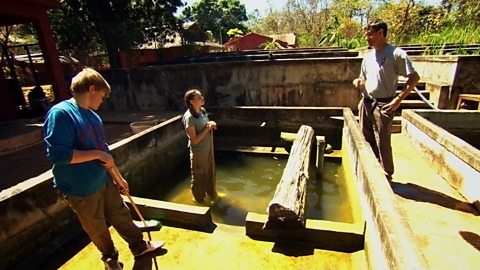Eight teenagers from the UK visit Madagascar to explore the impact of tourism on the African island.
The video
KS3 Geography. Africa - Conservation in Madagascar.
The balance between tourism and conservation
STEVE BACKSHALL: This is Madagascar. It’s a vast island in the Indian Ocean off the east coast of Africa. And it’s home to some of the most unique and rare creatures on the planet. Incredibly 80% of the wildlife here exists nowhere else on earth. But it’s a paradise under threat.
I’ve sent eight ordinary kids from the UK to discover for themselves how the people and animals can both survive here together. This was never going to be easy.
CHILD NARRATOR: When we were on our mission it was unbelievable to see how many tourists wanted to get up close to the wildlife.
CHILD: So many tourists around here. It’s absolutely packed.
CHILD NARRATOR: But sometimes loads of tourists isn’t such a good thing. Their impact can have a negative effect on the environment. One of the major reasons so many tourists go to Madagascar is to see humpback whales.
[ON A BOAT AT SEA]
CHILDREN: Oh boy! / Oh wow! / Oh! / Oh, that’s cool.
CHILD NARRATOR: And it’s easy to see why it’s such a popular tourist attraction.
CHILDREN: Whoa! That’s close!
CHILD NARRATOR: The problem is that too many tourist boats can cause whales stress and confusion. [WHALE SONG] We discovered that sound is really important for whales to be able to communicate with each other.
CHILD: Their song is actually really beautiful. Like ‘Bleugh-bleugh-la-la-la’!
CHILD NARRATOR: And around the world it has been found that noise pollution can be extremely dangerous for whales.
CHILD: Too many tourists can wreck and destroy the whole point that the tourists are there.
CHILD: I personally think that this island is much better without tourism, because I think the tourists ruin a lot of the natural beauty of this island.
CHILD NARRATOR: Should we stop tourists from getting up close to wildlife? What do you think?
[QUESTION MARK]
CHILD NARRATOR: We discovered that Madagascar is an extremely poor place.
CHILD: You see these kind of things on TV, but when you see them in reality it’s totally different.
CHILD NARRATOR: One of the things we learnt on our mission is how tourists can have a positive effect in Madagascar.
CHILD TO SELLER: Merci. Merci beaucoup.
And I bought my mum a scarf and like to see their faces glow when I bought it made my day like.
Thank you. Thank you. Thank you.
CHILD NARRATOR: We found out that handmade products that tourists buy create jobs for local people. And souvenirs in particular are a real money-spinner.
ADULT VOICE: [ENTERING WORKSHOP] Bonjour. Nadine.
CHILDREN: Bonjour.
ADULT: So are you ready to stuff some whales and to make them?
CHILDREN: Yes. Definitely.
ADULT: Good.
CHILD: We’re just stuffing some broken-up foam into the whale to make it into a pillow.
CHILD: She makes five of these big ones in one day. I reckon I could make about five of these little ones. Maybe.
CHILD: No you couldn’t!
CHILD: Actually, no!
ADULT: So our idea in the future is that people care more about the whales after working with us, so they will see that tourists buy this kind of things because whales exist. So they will care about whales existing and coming to Madagascar. And this is the link that we do between economy and of course the conservation of marine mammals, the conservation of the whales.
CHILD: [HAVING HIS WORK ASSESSED] Good? Cool!
CHILD: Yeah, this is the first thing out of fabric that like I’ve made and…Like obviously I didn’t even make…I just stuffed it and then sewed up the hole so hopefully it will sell.
CHILD NARRATOR: It was amazing to see what other things the locals can make with a bit of imagination.
CHILD: I had absolutely no idea that you could make jewellery out of so much stuff.
CHILDREN: Whale tail. Everything’s hand-worked…
CHILD: It’s great that they can make these products and they’re sustainable and help the environment and they earn money at the same time.
CHILD NARRATOR: The extra income from all these products makes it a win-win situation for both the locals and the whales.
CHILD: All the products get sold here for souvenirs. Like when people come in from having their boat trip. It’s giving the people that make them a job, so I just think it’s like a great cause and it’s really good fun just to be part of it.
CHILD NARRATOR: The tourists bringing in money for local people - surely this is a good thing for wildlife? What do you think?
Video summary
Download/print a transcript of the video.
The teenagers consider the pros and cons of tourism and whether Madagascar would be better off without tourists.
Tourism is important to the economy of Madagascar, with visitors often making boat trips to see humpback whales. But the level of tourism is creating problems.
The UK teenagers meet local people who sell souvenirs that help bring money into the local economy and create jobs for local people. They work alongside local people to make whale souvenirs and think about the link between a successful economy and conservation.
This clip was originally from the series Deadly Dilemmas.
Teacher Notes
Download/print a copy of the Teacher Notes for this video.
Teacher Notes prepared in partnership with the Geographical Association.
Before watching the video
- Locate Madagascar using maps of the world and of Africa.
- Discuss with students why tourism is important and why it can cause challenges. For example, they may consider that it creates employment; however, lots of tourists could create noise pollution and upset local wildlife. This could lead to a discussion about whether tourism should be allowed in conservation zones.
- Introduce key terms such as:
Conservation: the practice of protecting Earth's natural resources for the benefit of current and future generations.
Endangered: a species is at a high risk of extinction, or disappearing forever.
Tourism: travelling away from home for pleasure, for example a holiday.
Economy: how a country or place is doing in making goods, and how much money it has.
During the video
You may wish to stop at relevant points during this short film to pose questions and check understanding, or wait until the end. Useful questions might include:
- Why do many tourists visit Madagascar?
- How is tourism having an impact on the environment in Madagascar?
- Why is tourism important to the people living in Madagascar?
- Why are the souvenirs important?
- What else could be done?
After watching the video
- The clip could be used to start a discussion for and against tourism in Madagascar.
- Students could be encouraged to discuss wildlife regulations that govern tourism. How are animals affected by tourism? What is the consequence of increasing numbers of tourists?
- In groups, students could agree a set of wildlife regulations that tourists should abide by.
- Students can be asked to debate the impact of tourism on wildlife and the pros and cons of tourism in general. Are there any positives to tourism in Madagascar? Can the economy and conservation support each other?
- In pairs, students can work to summarise different sides of the argument.
- As a further activity, the class can be divided into groups to produce a TV advert (in storyboard form or as a short film), radio jingle or poster to persuade people to visit Madagascar in a way that supports the local economy in their efforts to protect the whales.
Curriculum links
This clip will be relevant for teaching Geography at KS3 in England and Northern Ireland, 3rd/4th Level in Scotland and Progression Step 4 in Wales.
Where next?
Around the world there are rules and regulations governing tourism. An outstanding example of this is the Galapagos Islands in South America. If you visit the Galapagos Islands National Park there are a range of regulations to follow, which include remaining on visitor trails, taking all rubbish with you and staying at least two metres away from all wildlife.
Research tourism in the Galapagos. What are the similarities and differences between tourism in Madagascar and the Galapagos Islands?
Links
Impacts of tourism:
http://unitedkingdom.bahce.site/bitesize/topics/zcmfb9q/articles/znspn9q
Changing patterns and nature of tourism:
http://unitedkingdom.bahce.site/bitesize/guides/z2nnqty/revision/1
Global tourism:
http://unitedkingdom.bahce.site/bitesize/guides/zkgxsbk/revision/1
Benefits and challenges of conservation:
http://unitedkingdom.bahce.site/bitesize/guides/zsbn7p3/revision/6
More from Africa - Conservation in Madagascar:
How fishing on a coral reef in Madagascar causes habitat loss. video
The teenagers consider a local conservation dilemma: families who fish on a coral reef even though the activity is destroying the habitat.

How deforestation in Madagascar is threatening animal habitats. video
The teenagers investigate how deforestation in Madagascar threatens the lemur's habitat, but happens in response to local needs.

When the need for food threatens endangered species. video
The teenagers consider what can be done to protect bats, which are often hunted as a source of meat although endangered.

Protecting endangered species in Madagascar. video
The teenagers consider two contrasting wildlife conservation projects, both working to protect endangered species.
